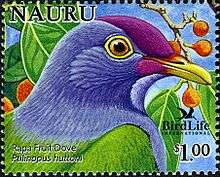Rapa fruit dove
| Rapa fruit dove | |
|---|---|
 | |
| Scientific classification | |
| Kingdom: | Animalia |
| Phylum: | Chordata |
| Class: | Aves |
| Order: | Columbiformes |
| Family: | Columbidae |
| Genus: | Ptilinopus |
| Species: | P. huttoni |
| Binomial name | |
| Ptilinopus huttoni Finsch, 1874 | |
The Rapa fruit dove (Ptilinopus huttoni) is a species of bird in the family Columbidae. It is endemic to French Polynesia. Its natural habitat is subtropical or tropical moist lowland forests. It is threatened by habitat loss.
Description
The dove is approximately 31 centimeters tall, a medium sized pigeon. It mainly has green plumage, especially on its wings. Pale blue-green plumage is on the foreparts (head, neck, chest, upper back) shading into green of body above. It also has a yellowish-white tip of tail, not sharply demarcated with right rose crown, face and throat, and a dark rose undertail. It has a yellow lower belly and edges of wing feathers with rose-purple band below cloven chest feathers. It owns a yellow bill and iris along with red legs.[2]
Distribution and population
This species is endemic to the small island of Rapa in Tubuai Islands, French Polynesia. It appears to rely on undisturbed forest fragments at altitudes of to 450 m above sea level, and avoids coastal vegetation or secondary forest. The population of the bird is estimated at about 270-274 individuals with about 180 of them being mature.[2]
Diet
The species feeds on flowers and fleshy fruit, which may include the introduced Chinese guava Psidium cattleianum.[1]
Conservation
Destruction of forests due to goats, cattle, fires used to clear out forest to grazing land for livestock, and deforestation are main threats to the rare dove. Predation by feral cats and the Polynesian rat are also possible threats to this species.[1][2]
References
- 1 2 3 BirdLife International (2015). "Ptilinopus huttoni". IUCN Red List of Threatened Species. Version 2015. International Union for Conservation of Nature. Retrieved 24 January 2016.
- 1 2 3 "Rapa Fruit dove Ptilinopus huttoni - Species Factsheet". Birdlife International.
